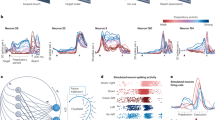Abstract
Understanding the coordinate systems in which the motor cortical cells encode movement parameters such as direction is a fundamental yet unresolved issue. Although many studies have assumed that motor cortex encodes direction in an extrinsic, Cartesian (CA) coordinate system, other studies have provided evidence for encoding in intermediate coordinate systems such as a shoulder-centered (SC) or in a purely intrinsic, joint-angle-based (JA) coordinate frame. By simultaneously recording from multiple single units in primary motor cortex, we examined movement direction encoding under each of these three coordinate systems. We directly compared the degree of directional tuning invariance over multiple sub-regions in the workspace. We also compared the mutual information between neuronal firing rate and movement direction in the three systems. We observed a broad range of directional invariance in all three coordinate systems with no strong dominance of any single coordinate system. The mutual information analyses corroborated this observation. However, we found a small but significant bias toward the SC coordinate frame, which was also supported by population vector decoding. Similar results were found when we compared hand/torque force direction encoding in all three coordinate systems. These results suggest that the motor cortex employs a coordinate system that is yet to be discovered or perhaps that the motor cortex should not be viewed as a substrate for any coordinate system representation.











Similar content being viewed by others
References
Ajemian R, Bullock D, Grossberg S (2000) Kinematic coordinates in which motor cortical cells encode movement direction. J Neurophysiol 84:2191–2203
Ashe J (1997) Force and the motor cortex. Behav Brain Res 87:255–269
Caminiti R, Johnson P, Urbano A (1990) Making arm movements within different parts of space: dynamic aspects in the primate motor cortex. J Neurosci 10:2039–2058
Caminiti R, Johnson P, Galli C, Ferraina S, Burnod Y (1991) Making arm movements within different parts of space: the premotor and motor cortical representation of a coordinate system for reaching to visual targets. J Neurosci 11:1182–1197
Cheney PD, Fetz EE (1980) Functional classes of primate corticomotoneuronal cells and their relation to active force. J Neurophysiol 44:773–791
Evarts EV (1968) Relation of pyramidal tract activity to force exerted during voluntary movement. J Neurophysiol 31:14–27
Flanders M, Tillery S, Soechting JF (1992) Early stages in a sensorimotor transformation. Behav Brain Sci 15:309–362
Georgopoulos AP, Kalaska JF, Caminiti R, Massey JT (1982) On the relations between the direction of two-dimensional arm movements and cell discharge in primate motor cortex. J Neurosci 2:1527–1537
Hocherman S, Wise S (1991) Effects of hand movement path on motor cortical activity in awake, behaving rhesus monkeys. Exp Brain Res 83:285–302
Kakei S, Hoffman DS, Strick PL (1999) Muscle and movement representation in the primary motor cortex. Science 285:2136–2139
Lacquaniti F, Guigon E, Bianchi L, Ferraina S, Caminiti R (1995) Representing spatial information for limb movement: role of area 5 in the monkey. Cereb Cortex 5:391–409
Moran DW, Schwartz AB (1999) Motor cortical representation of speed and direction during reaching. J Neurophysiol 82:2676–2692
Morrow MM, Miller LE (2003) Prediction of muscle activity by populations of sequentially recorded primary motor cortex neurons. J Neurophysiol 89:2279–2288
Paninski L, Fellows MR, Hatsopoulos NG, Donoghue JP (2004) Spatiotemporal tuning of motor cortical neurons for hand position and velocity. J Neurophysiol 91:515–532
Scott SH (1999) Apparatus for measuring and perturbing shoulder and elbow joint positions and torques during reaching. J Neurosci Methods 89:119–127
Scott SH, Kalaska JF (1997) Reaching movements with similar hand paths but different arm orientations. I. Activity of individual cells in motor cortex. J Neurophysiol 77:826–852
Sergio LE, Kalaska JF (2003) Systematic changes in motor cortex cell activity with arm posture during directional isometric force generation. J Neurophysiol 89:212–228
Sergio LE, Hamel-Paquet C, Kalaska JF (2005) Motor cortex neural correlates of output kinematics and kinetics during isometric-force and arm-reaching tasks. J Neurophysiol 94:2353–2378
Smith AM, Hepp-Reymond MC, Wyss UR (1975) Relation of activity in precentral cortical neurons to force and rate of force change during isometric contractions of finger muscles. Exp Brain Res 23:315–332
Soechting JF, Flanders M (1989) Sensortimotor representations for pointing to targets in three-dimensional space. J Neurophysiol 62:582–594
Soechting JF, Helms Tillery SI, Flanders M (1990) Transformation from head- to shoulder-centered representation of target direction in arm movements. J Cogn Neurosci 2:32–43
Taira M, Boline J, Smyrnis N, Georgopoulos AP, Ashe J (1996) On the relations between single cell activity in the motor cortex and the direction and magnitude of three-dimensional static isometric force. Exp Brain Res 109:367–376
Thach WT (1978) Correlation of neural discharge with pattern and force of muscular activity, joint position, and direction of intended next movement in motor cortex and cerebellum. J Neurophysiol 41:654–676
Todorov E, Jordan MI (2002) Optimal feedback control as a theory of motor coordination. Nat Neurosci 5:1226–1235
Wolovich WA (1987) Robotics: basic analysis and design. Holt, Rinehart and Winston, New York
Acknowledgments
We thank Greg Ojakangas for rederiving and implementing the equations of motion of the exoskeletal robot together with the animal’s arm. We also thank S. Francis, D. Paulsen and J. Reimer for training the monkeys and collecting the data. Finally, we thank Z. Haga for helpful discussions regarding the data analyses. This work was supported by a grant from the Whitehall Foundation and grants N01-NS-2-2345 and R01 NS45853-01A2 from the NINDS. N. Hatsopoulos has stock ownership in a company, Cyberkinetics, Inc., that is commercializing neural prostheses for severely motor disabled people.
Author information
Authors and Affiliations
Corresponding author
Rights and permissions
About this article
Cite this article
Wu, W., Hatsopoulos, N. Evidence against a single coordinate system representation in the motor cortex. Exp Brain Res 175, 197–210 (2006). https://doi.org/10.1007/s00221-006-0556-x
Received:
Accepted:
Published:
Issue Date:
DOI: https://doi.org/10.1007/s00221-006-0556-x




